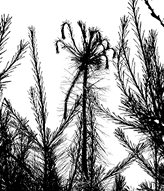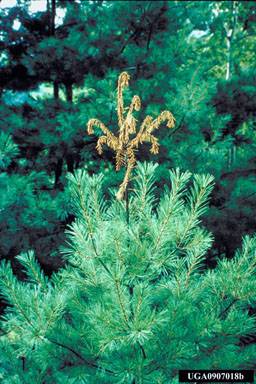DACF Home → Bureaus & Programs → Maine Forest Service → Forest Health & Monitoring → Forest Pest Index → White Pine Weevil
WHITE PINE WEEVIL
Pissodes strobi (Peck)

Symptoms and Damage
The white pine weevil kills the top of conifers and is the most serious economic insect pest of white pine. One of the first symptoms of attack in the spring is the presence of pitch flowing from the feeding punctures in the previous year's leading shoot. Beginning in late June the new growth on infested shoots starts to droop (see photo). Shortly thereafter the tops die and turn brown. Up to 2-3 years of top growth may be destroyed. The damage results in trees that are multi-topped, crooked, and of much lower value for saw-timber. Plantations, open-grown trees, and ornamentals are most heavily affected.

Photo: E. Bradford Walker, Vermont Department of Forests, Parks and Recreation, Bugwood.org
Hosts
Eastern white pine, Colorado blue spruce, Norway spruce, jack pine, Scotch pine, mugo pine, and native spruces.
Description and Life Cycle
The adults, small brownish weevils (snout beetles), become active very early in the spring and move up on to the previous years' shoots to feed. They may frequently be found "nestled" around bud clusters at the tips of the shoots. The adults mate and lay eggs from early May through June in the bark of the previous year's leader. Upon hatching the young, legless grubs start tunneling downward under the bark. The grubs gradually enlarge their tunnels as they progress downward until they completely girdle the infested shoot killing as much as 1½ - 2 feet of the leader. Mature grubs are yellowish white, legless and about 7 mm long. They bore slightly into the woody stem, form a fibrous chip cell and pupate. Adults begin emerging as early as mid-July. The new adults feed for a time on new shoots then enter the ground litter at the base of trees to overwinter.
CONTROL MEASURES IN PLANTATIONS
Non-chemical:
Preventive Pruning of Infested Leaders - At low infestation levels the prompt removal and destruction of infested leaders before the beetles emerge reduces the chance of weevil population buildup. Prune infested leaders at a point just into healthy tissue below the tunneling grubs. Immediate destruction (burning is suggested) of cut leaders is necessary to destroy the larvae and pupae. Wilting of leaders may be detected from late June through July. Pruning should be completed by mid-July prior to adult emergence and before completion of shoot growth. This encourages secondary budding on the pruned leader and may result in faster terminal recovery. Early pruning may also prevent the grubs from penetrating the node of the first whorl of branches, thereby reducing the amount of injury. (See corrective pruning below as a follow-up).
Cultural Methods:
1) Consider refraining from planting white pine or spruce in areas of high weevil hazard such as heavy clay soils and heavily sodded fields.
2) Partial shade helps prevent the leader from becoming an optimum egg laying site because of its effect in reducing bark thickness and bark temperatures. Therefore overtopping hardwoods or conifers help protect young pine and spruce from weevil damage. Density of the overtopping species should be managed to maintain about 45-50% shade until final release when the pines reach a height of 16 to 18 feet.
3) Close spacing of trees in a plantation will stimulate height growth and natural pruning to permit faster recovery.
Chemical*:
Spray the leaders in the spring after several days of temperatures above 60°F, usually mid April in the Augusta area (before May 1 in most years). Make sure leaders are thoroughly covered. Most control operations will require 2-3 gallons of mixed spray per acre. Refer to the insecticide container label for mixing instructions. Spray all leaders each time an area is sprayed and whenever current damage approaches 10% of total number of trees. High value Christmas trees may need to be sprayed every year. Spacing and tree height will greatly influence the time necessary to spray each area. If spraying is done in the fall, add the recommended extender to the insecticide.
Lorsban**, Dimilin**, Talstar and Dibrom are currently registered for white pine weevil control by licensed pesticide applicators. Dimilin is an insect growth regulator that acts by interfering with deposition of insect chitin. Efficacy of Dimilin against the weevil is greatly enhanced by the addition of 6-7 oz. of dormant oil (without ethion) per gallon of spray mixture. Caution: dormant oil may cause a reduction of blue color when applied to blue spruce.
CONTROL MEASURES IN ORNAMENTALS
Non-chemical:
Cover leader with a nylon stocking secured with a twist tie from the end of March until the buds begin to expand to prevent the weevil from laying eggs.
Or
Preventive pruning of infested leaders (see above) followed by corrective pruning described below, can provide good control and management of this pest around landscapes, especially in ornamentals that are regularly pruned or cut back or in a hedge.
Corrective Pruning - Remove all but a single dominant shoot at the topmost healthy whorl to encourage formation of a new leader. Corrective pruning may be postponed until the year following attack to make sure that at least one live lateral will survive possible ice-snow damage, or a possible second successive year of weevil attack.
Chemical*:
On ornamental conifers around the yard homeowners can use Pyrenone or other pyrethrins labeled for ornamentals. Apply at 14 to 20 day intervals, after several days of temperatures above 60°F (usually mid-April in Augusta). Be sure to check the label for use instructions on ornamental trees. Spray only the leaders at the recommended dilution rate.
*NOTE: These recommendations are not a substitute for pesticide labeling. Read the label before applying any pesticide. Pesticide recommendations are contingent on continued EPA and Maine Board of Pesticides Control registration and are subject to change.
** Lorsban and Dimilin are restricted-use pesticides to be sold only by licensed dealerships to registered pesticide applicators.
MAINE DEPARTMENT OF AGRICULTURE, CONSERVATION AND FORESTRY
Maine Forest Service - Forest Health and Monitoring Division
April 2008
For More Information:
US Forest Service: Forest Insect and Disease Leaflet 21
US Forest Service: How to Manage Eastern White Pine to Minimize Damage from Blister Rust and White Pine Weevil NA-FR-01-93
BugWood Wiki